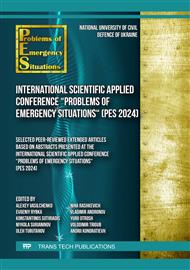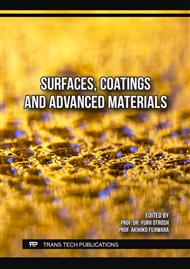[1]
O. Rybalova, S. Artemiev, M. Sarapina, B. Tsymbal, A. Bakhareva, O. Shestopalov, O. Filenko, Development of methods for estimating the environmental risk of degradation of the surface water state. Eastern-European Journal of Enterprise Technologies. 2/10(92) (2018) 4–17.
DOI: 10.15587/1729-4061.2018.127829
Google Scholar
[2]
A. Vasenko, O. Rybalova, O. Kozlovskaya, A study of significant factors affecting the quality of water in the Oskil River (Ukraine). Eastern-European Journal of Enterprise Technologies. 3/10(81) (2016) 48–55.
DOI: 10.15587/1729-4061.2016.72415
Google Scholar
[3]
V. Andronov, B. Pospelov, E. Rybka, Increase of accuracy of definition of temperature by sensors of fire alarms in real conditions of fire on objects. Eastern-European Journal of Enterprise Technologies. 4/5 (82) (2016) 38–44.
DOI: 10.15587/1729-4061.2016.75063
Google Scholar
[4]
V. Tiutiunyk, H. Ivanets, I. Tolkunov, E. Stetsyuk, System approach for readiness assessment units of civil defense to actions at emergency situations. Naukovyi Visnyk Natsionalnoho Hirnychoho Universytetu. 1 (2018) 99–105.
DOI: 10.29202/nvngu/2018-1/7
Google Scholar
[5]
K. Korytchenko, O. Sakun, D. Dubinin, Y. Khilko, E. Slepuzhnikov, A. Nikorchuk, I. Tsebriuk, Experimental investigation of the fire-extinguishing system with a gas-detonation charge for fluid acceleration. Eastern-European Journal of Enterprise Technologies. 3/5 (93) (2018) 47–54.
DOI: 10.15587/1729-4061.2018.134193
Google Scholar
[6]
Y. Danchenko, V. Andronov, E. Barabash, T. Obigenko, E. Rybka, R. Meleshchenko, A. Romin, Research of the intramolecular interactions and structure in epoxyamine composites with dispersed oxides. Eastern-European Journal of Enterprise Technologies. 6/12 (90) (2017) 4–12.
DOI: 10.15587/1729-4061.2017.118565
Google Scholar
[7]
V. Barannik, Y. Babenko, O. Kulitsa, V. Barannik, A. Khimenko, O. Matviichuk-Yudina, Significant microsegment transformants encoding method to increase the availability of video information resource. ATIT 2020 - Proceedings: 2020 2nd IEEE International Conference on Advanced Trends in Information Theory. 9349256 (2020) 52-56.
DOI: 10.1109/atit50783.2020.9349256
Google Scholar
[8]
M. Vasiliev, I. Movchan, O. Koval, Diminishing of ecological risk via optimization of fire-extinguishing system projects in timber-yards. Naukovyi Visnyk Natsionalnoho Hirnychoho Universytetu. 5 (2001) 106–113
Google Scholar
[9]
M. Kustov, V. Kalugin, V. Tutunik, O. Tarakhno, Physicochemical principles of the technology of modified pyrotechnic compositions to reduce the chemical pollution of the atmosphere. Voprosy Khimii i Khimicheskoi Tekhnologii. 1 (2019) 92–99.
DOI: 10.32434/0321-4095-2019-122-1-92-99
Google Scholar
[10]
A. Semko, M. Beskrovnaya, S. Vinogradov, I. Hritsina, N. Yagudina, The usage of high speed impulse liquid jets for putting out gas blowouts. Journal of Theoretical and Applied Mechanics (Poland). 3 (2017) 655–664.
Google Scholar
[11]
V.V. Tatarinov, U.V. Prus, A.A. Kirsanov, Decision support software for chemical accident elimination management. AIP Conference Proceedings. 2195 (2019) 020076.
DOI: 10.1063/1.5140176
Google Scholar
[12]
M. Martínez-García, Y. Zhang, K. Suzuki, Y.D. Zhang, Deep Recurrent Entropy Adaptive Model for System Reliability Monitoring. IEEE Transactions on Industrial Informatics. 17(2) (2021) 839–848.
DOI: 10.1109/tii.2020.3007152
Google Scholar
[13]
F. Khan, S. Rathnayaka, S. Ahmed, Methods and models in process safety and risk management: Past, present and future. Process Safety and Environmental Protection. 98 (2015) 116-147.
DOI: 10.1016/j.psep.2015.07.005
Google Scholar
[14]
B. Pospelov, V. Kovrehin, E. Rybka, O. Krainiukov, O. Petukhova, T. Butenko, P. Borodych, I. Morozov, O. Horbov, I. Hrachova, Development of a method for detecting dangerous states of polluted atmospheric air based on the current recurrence of the combined risk. Eastern-European Journal of Enterprise Technologies. 5/9 (107) (2020) 49–56.
DOI: 10.15587/1729-4061.2020.213892
Google Scholar
[15]
O. Rybalova, S. Artemiev, Development of a procedure for assessing the environmental risk of the surface water status deterioration. Eastern-European Journal of Enterprise Technologies. 5/10 (89) (2017) 67–76.
DOI: 10.15587/1729-4061.2017.112211
Google Scholar
[16]
O.M. Pshinko, M.M. Biliaiev, O.Y. Gunko, Localization of the air pollution zone in case of liquidation of an accident with chemically hazardous cargo. Science and Transport Progress. 27 (2009) 143–148.
DOI: 10.15802/stp2009/14261
Google Scholar
[17]
S.Ia. Maistrenko, V.P. Bespalov, K.V. Khurtsylava, T.O. Zahreba, Prototypna versiia systemy «Povitria»: kerivnytstvo korystuvacha. Kyiv, 2018 [in Ukrainian].
Google Scholar
[18]
B. Pospelov, E. Rybka, R. Meleshchenko, P. Borodych, S. Gornostal, Development of the method for rapid detection of hazardous atmospheric pollution of cities with the help of recurrence measures. Eastern-European Journal of Enterprise Technologies. 1/10 (97) (2019) 29–35.
DOI: 10.15587/1729-4061.2019.155027
Google Scholar
[19]
B. Pospelov, V. Andronov, E. Rybka, R. Meleshchenko, S. Gornostal, Analysis of correlation dimensionality of the state of a gas medium at early ignition of materials. Eastern-European Journal of Enterprise Technologies. 5/10 (2018) 25–30.
DOI: 10.15587/1729-4061.2018.142995
Google Scholar
[20]
D. Dubinin, K. Korytchenko, A. Lisnyak, I. Hrytsyna, V. Trigub, Improving the installation for fire extinguishing with finelydispersed water. Eastern-European Journal of Enterprise Technologies. 2/10 (92) (2018) 38–43.
DOI: 10.15587/1729-4061.2018.127865
Google Scholar
[21]
B. Pospelov, V. Andronov, E. Rybka, V. Popov, A. Romin, Experimental study of the fluctuations of gas medium parameters as early signs of fire. Eastern-European Journal of Enterprise Technologies. 1/10 (91) (2018) 50–55.
DOI: 10.15587/1729-4061.2018.122419
Google Scholar
[22]
B. Pospelov, V. Andronov, E. Rybka, O. Krainiukov, N. Maksymenko, R. Meleshchenko, Y. Bezuhla, I. Hrachova, R. Nesterenko, A. Shumilova, Mathematical model of determining a risk to the human health along with the detection of hazardous states of urban atmosphere pollution based on measuring the current concentrations of pollutants. Eastern-European Journal of Enterprise Technologies. 4/10 (2020) 37–44.
DOI: 10.15587/1729-4061.2020.210059
Google Scholar
[23]
B. Pospelov, V. Kovrehin, E. Rybka, O. Krainiukov, O. Petukhova, T. Butenko, P. Borodych, I. Morozov, O. Horbov, I. Hrachova, Development of a method for detecting dangerous states of polluted atmospheric air based on the current recurrence of the combined risk. Eastern-European Journal of Enterprise Technologies. 5/9(107) (2020) 49–56.
DOI: 10.15587/1729-4061.2020.213892
Google Scholar
[24]
S. Vambol, V. Vambol, O. Kondratenko, Y. Suchikova, O. Hurenko, Assessment of improvement of ecological safety of power plants by arranging the system of pollutant neutralization. Eastern-European Journal of Enterprise Technologies. 3/10(87) (2017) 63–73.
DOI: 10.15587/1729-4061.2017.102314
Google Scholar
[25]
B. Pospelov, V. Andronov, E. Rybka, V. Popov, O. Semkiv, Development of the method of frequencytemporal representation of fluctuations of gaseous medium parameters at fire. Eastern-European Journal of Enterprise Technologies. 2/10(92) (2018) 44–49.
DOI: 10.15587/1729-4061.2018.125926
Google Scholar
[26]
V. Sadkovyi, B. Pospelov, V. Andronov, E. Rybka, O. Krainiukov, A. Rud, K. Karpets, Y. Bezuhla, Construction of a method for detecting arbitrary hazard pollutants in the atmospheric air based on the structural function of the current pollutant concentrations. Eastern-European Journal of Enterprise Technologies. 6(10) (2020) 14-22.
DOI: 10.15587/1729-4061.2020.218714
Google Scholar
[27]
B. Pospelov, E. Rybka, R. Meleshchenko, O. Krainiukov, S. Harbuz, Y. Bezuhla, I. Morozov, A. Kuruch, O. Saliyenko, R. Vasylchenko, Use of uncertainty function for identification of hazardous states of atmospheric pollution vector. Eastern-European Journal of Enterprise Technologies. 2/10 (2020) 6–12.
DOI: 10.15587/1729-4061.2020.200140
Google Scholar
[28]
D. Dubinin, V. Avetisyan, K. Ostapov, S. Shevchenko, S. Hovalenkov, D. Beliuchenko, A. Maksymov, O. Cherkashyn, Investigation of the effect of carbon monoxide on people in case of fire in a building. Sigurnost. 62/4 (2020) 347–357.
DOI: 10.31306/s.62.4.2
Google Scholar
[29]
V.S. Babkov, T.Yu. Tkachenko, Analiz matematicheskih modeley rasprostraneniya primesey ot tochechnyih istochnikov. Nauchnyie trudyi DonNTU. Seriya «Informatika, kibernetika i vyichislitelnaya tehnika». 13(185) (2011) 147–155 [in Ukrainian].
Google Scholar
[30]
Recommended Models // US Environmental Protection Agency, URL: http://www.epa.gov.
Google Scholar
[31]
A.J. Cimorelli, S.G. Perry, A. Venkatram [et al.], AERMOD: A dispersion model for industrial sourceapplications Part I: General model formulation and boundary layer characterization. (accepted for publication). Journal of Applied Meteorology. 44(5) (2005) 682–693.
DOI: 10.1175/jam2227.1
Google Scholar
[32]
T. Elperin, A. Fominykh, B. Krasovitov, A. Vikhansky, Effect of rain scavenging on altitudinal distribution of soluble gaseous pollutants in the atmosphere. Atmospheric Environment. 45(14) (2011) 2427–2433.
DOI: 10.1016/j.atmosenv.2011.02.008
Google Scholar
[33]
M. Kustov, E. Slepuzhnikov, V. Lipovoy, I. Khmyrov, D. Firdovsi, O. Buskin, Procedure for implementation of the method of artificial deposition of radioactive substances from the atmosphere. Nuclear and Radiation Safety. 3/83 (2019) 13–25.
DOI: 10.32918/nrs.2019.3(83).02
Google Scholar
[34]
S. Gautam, T. Liu, D. Cole, Sorption, Structure and Dynamics of CO2 and Ethane in Silicalite at High Pressure: A Combined Monte Carlo and Molecular Dynamics Simulation Study. Molecules. 24(1) (2019) 99.
DOI: 10.3390/molecules24010099
Google Scholar
[35]
A.K. Hua, P.S. Lakey, M. Shiraiwa, Multiphase Kinetic Multilayer Model Interfaces for Simulating Surface and Bulk Chemistry for Environmental and Atmospheric Chemistry Teaching. Journal of Chemical Education. 99(3) (2022) 1246–1254.
DOI: 10.1021/acs.jchemed.1c00931
Google Scholar
[36]
M.V. Kustov, O.Ie. Basmanov, A.S. Melnychenko, Modeliuvannia zony khimichnoho urazhennia v umovakh lokalizatsii nadzvychainoi sytuatsii. Problemy nadzvychainykh sytuatsii. 32 (2020) 142–157 [in Ukrainian].
Google Scholar
[37]
M.V. Kustov, O.Ie. Basmanov, O.A. Tarasenko, A.S. Melnychenko, Prohnozuvannia masshtabiv khimichnoho urazhennia za umov osadzhennia nebezpechnoi rechovyny. Problemy nadzvychainykh sytuatsii. 33 (2021) С. 72–83 [in Ukrainian].
Google Scholar
[38]
M. Kustov, A. Melnychenko, O. Basmanov, O. Tarasenko, Modeling of Gas Sorption Process by Dispersed Liquid Flow. Materials of Science Forum. 1068 (2022) 239–247.
DOI: 10.4028/p-jdydlo
Google Scholar
[39]
A. Melnychenko, M. Kustov, O. Basmanov, O. Tarasenko, O. Bogatov, M. Kravtsov, O. Petrova, T. Pidpala, O. Karatieieva, N. Shevchuk, Devising a Procedure to Forecast the Level of Chemical Damage to the Atmosphereduring Active Deposition of Dangerous Gases. Eastern-European Journal of Enterprise Technologies. 1(10(115)) (2022) 31–40.
DOI: 10.15587/1729-4061.2022.251675
Google Scholar
[40]
M. Kustov, A. Melnychenko, D. Taraduda, A. Korogodska, Research of the chlorine sorption processes when its deposition by water aerosol. Materials of Science Forum. 1068 (2021) 361–373.
DOI: 10.4028/www.scientific.net/msf.1038.361
Google Scholar



